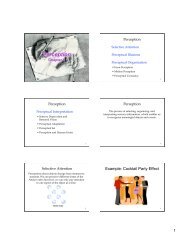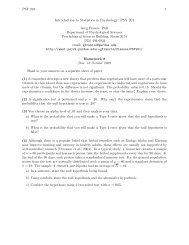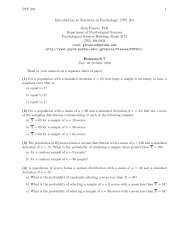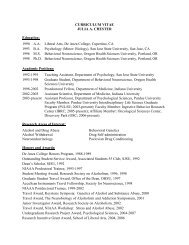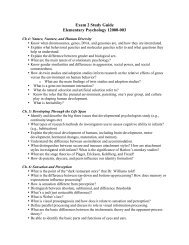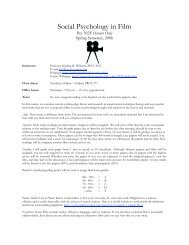Sensation & Perception
Sensation & Perception
Sensation & Perception
You also want an ePaper? Increase the reach of your titles
YUMPU automatically turns print PDFs into web optimized ePapers that Google loves.
<strong>Sensation</strong> & <strong>Perception</strong><br />
Chapter 6<br />
Psy 12000.003<br />
Announcement<br />
• Participants Needed<br />
– $10 to participate in experiment.<br />
– You (ask a friend, too)<br />
• Contact: Eric Wesselmann<br />
– edwesse@psych.purdue.edu<br />
The Dark Restaurant<br />
“I went to this restaurant in Berlin…”<br />
• http://www.unsicht-bar.com/unsicht-barberlin-v2/en/html/home_1_idea.html<br />
1<br />
Exam 1<br />
• Top Score: 50<br />
• Mean: 43.4<br />
• Median: 44.5<br />
• Mode: 44<br />
• SD: 5.11<br />
• Problems:<br />
– Start time screwed up for both; got resolved within 15 minutes<br />
– Duplicate question (my fault)<br />
– Wrong answers for 3 rd graph question (changed within 15 minutes, only<br />
affected 5 students; their scores have been corrected)<br />
• HELP LINE: 1-800-936-6899<br />
• Suggestions:<br />
– No go back?<br />
– Others? 2<br />
<strong>Sensation</strong> & <strong>Perception</strong><br />
How do we construct our representations of the external<br />
world?<br />
• To represent the world, we must first detect<br />
physical energy (a stimulus) from the<br />
environment and convert it into neural<br />
signals. This is a process called sensation.<br />
• Wilhelm Wundt: “Father of Experimental<br />
Psychology”<br />
– Introspectionism<br />
When we select, organize, and interpret our sensations,<br />
the process is called perception.<br />
3 4<br />
5<br />
The Senses<br />
• Traditional Five:<br />
– Sight<br />
– Hearing<br />
– Touch<br />
– Smell<br />
– Taste<br />
• Six others that humans have<br />
– Nociception (pain)<br />
– Equilbrioception (balance)<br />
– Proprioception & Kinesthesia (joint motion and acceleration)<br />
– Sense of time<br />
– Thermoception (temperature)<br />
– Magnetoception (direction)<br />
6<br />
1
Psychophysics<br />
A study of the relationship between physical<br />
characteristics of stimuli and our psychological<br />
experience with them.<br />
No<br />
Physical World<br />
Psychological<br />
World<br />
Light Brightness<br />
Sound Volume<br />
Pressure Weight<br />
Sugar Sweet<br />
Detection<br />
Intensity<br />
No No<br />
Observer’s Response<br />
Absolute<br />
Threshold<br />
Yes<br />
Detected<br />
Yes<br />
13<br />
A relative increase in<br />
mental intensity, Fechner<br />
realized, might be<br />
measured in terms of the<br />
relative increase in<br />
physical energy required<br />
to bring it about.<br />
22 nd October 1850<br />
Thresholds<br />
Gustav Fechner<br />
(1801-1887)<br />
Absolute Threshold: Minimum stimulation needed for<br />
an individual to detect a particular stimulus 50% of the<br />
time.<br />
Tell when you (the observer) detect the light. 15<br />
0 5 10 15 20 25<br />
16<br />
Stimulus Intensity (lumens)<br />
Subliminal Threshold: When<br />
stimuli are below one’s<br />
absolute threshold for<br />
conscious awareness.<br />
Subliminal Threshold<br />
Kurt Scholz/ Superstock<br />
17<br />
Proportion of “Yes” Responses<br />
0.00 0.50 1.00<br />
Difference Threshold<br />
Difference Threshold: Minimum difference between two<br />
stimuli required for detection 50% of the time, also called<br />
just noticeable difference (JND).<br />
No<br />
Difference<br />
Threshold<br />
No Yes<br />
Observer’s Response<br />
Tell when you (observer) detect a difference in the light.<br />
14<br />
18<br />
3
Weber’s Law<br />
Two stimuli must differ by a constant minimum<br />
percentage (rather than a constant amount), to be<br />
perceived as different. Weber fraction: k = δI/I.<br />
Stimulus Constant (k)<br />
Light 8%<br />
Weight 2%<br />
Tone 3%<br />
SDT Matrix<br />
The observer decides whether she hears the tone or not,<br />
based on the signal being present or not. This translates<br />
into four outcomes.<br />
Signal<br />
Decision<br />
Yes No<br />
Present Hit Miss<br />
Absent<br />
False<br />
Alarm<br />
Correct<br />
Rejection<br />
Now you see, now you don’t<br />
19<br />
21<br />
23<br />
Signal Detection Theory (SDT)<br />
Predicts how and when we detect the presence of a<br />
faint stimulus (signal) amid background noise (other<br />
stimulation). SDT assumes that there is no single<br />
absolute threshold and detection depends on:<br />
Person’s experience<br />
Expectations<br />
Motivation<br />
Level of fatigue<br />
Sensory Adaptation<br />
Diminished sensitivity as a consequence of constant<br />
stimulation.<br />
Put a band aid on your arm and after awhile<br />
you don’t sense it.<br />
<strong>Sensation</strong> without <strong>Perception</strong><br />
Video on Visual Prosopagnosia<br />
Carol Lee/ Tony Stone Images<br />
20<br />
22<br />
24<br />
4
Sense of Touch<br />
The sense of touch is a mix of four distinct skin senses<br />
—pressure, cold, warmth, and pain.<br />
Bruce Ayers/ Stone/ Getty Images<br />
Touch <strong>Sensation</strong>/<strong>Perception</strong><br />
• The intense tickling<br />
sensation that makes<br />
you laugh<br />
uncontrollably…<br />
– Only happens when<br />
someone else tickles<br />
you<br />
– You cannot tickle<br />
yourself and get this<br />
response (Blakemore, et al.,<br />
2000)<br />
• Why?<br />
Sensory Interaction<br />
When one sense affects another sense, sensory<br />
interaction takes place. So, the taste of strawberry<br />
interacts with its smell and its texture on the tongue to<br />
produce flavor.<br />
25<br />
27<br />
29<br />
Skin Senses<br />
Only pressure has identifiable receptors. All other skin<br />
sensations are variations of pressure, warmth, cold and<br />
pain.<br />
Burning hot<br />
Pressure Vibration Vibration<br />
Taste<br />
Cold, warmth and pain<br />
Traditionally, taste sensations consisted of sweet, salty,<br />
sour, and bitter tastes. Recently, receptors for a fifth<br />
taste have been discovered called “Umami”.<br />
Sweet Sour Salty Bitter Umami<br />
(Fresh<br />
Chicken)<br />
Taste<br />
Scientific American Frontiers:<br />
Tasters and Super-tasters<br />
26<br />
28<br />
30<br />
5
Smell<br />
Like taste, smell is a chemical sense. Odorants enter the<br />
nasal cavity to stimulate 5 million receptors to sense<br />
smell. Unlike taste, there are many different forms of<br />
smell.<br />
Smell and Memories<br />
The brain region for smell<br />
(in red) is closely<br />
connected with the brain<br />
regions involved with<br />
memory (limbic system).<br />
That is why strong<br />
memories are made<br />
through the sense of<br />
smell.<br />
Pheromones, Odor, and Sweaty<br />
T-Shirts<br />
• http://www.pbs.org/wgbh/evolution/library/<br />
01/6/l_016_08.html<br />
31<br />
33<br />
Age, Gender, and Smell<br />
Ability to identify smell peaks during early adulthood,<br />
but steadily declines after that. Women are better at<br />
detecting odors than men.<br />
Example of Sensory Interaction<br />
Audition/Vision<br />
Count the Fs:<br />
FINISHED FILES ARE THE RESULTS<br />
OF YEARS OF SCIENTIFIC STUDY<br />
COMBINED WITH THE EXPERIENCE<br />
OF YEARS.<br />
• Adaptive to prefer<br />
mate with different<br />
immune system to<br />
one’s own: MHC<br />
(major histocompatibility locus)<br />
• Women preferred the scents<br />
of T-shirts worn by men whose MHC<br />
Vision<br />
genes were different from their own. 35 36<br />
32<br />
34<br />
6
Transduction<br />
In sensation, the transformation of stimulus energy into<br />
neural impulses.<br />
Phototransduction: Conversion of light energy into<br />
neural impulses that the brain can understand.<br />
Light Characteristics<br />
� Wavelength (hue/color)<br />
� Intensity (brightness)<br />
� Saturation (purity)<br />
Wavelength (Hue)<br />
Violet Indigo Blue Green Yellow Orange Red<br />
400 nm 700 nm<br />
Long wavelengths<br />
Short wavelengths<br />
Different wavelengths of light result<br />
in different colors.<br />
37<br />
39<br />
41<br />
Both Photos: Thomas Eisner<br />
The Stimulus Input: Light Energy<br />
Hue (color) is the<br />
dimension of color<br />
determined by the<br />
wavelength of the<br />
light.<br />
Wavelength is the<br />
distance from the<br />
peak of one wave to<br />
the peak of the next.<br />
Intensity<br />
Amount of<br />
energy in a wave<br />
determined by<br />
the amplitude. It<br />
is related to<br />
perceived<br />
brightness.<br />
Wavelength (Hue)<br />
Intensity (Brightness)<br />
Visible<br />
Spectrum<br />
38<br />
40<br />
42<br />
7
Intensity (Brightness)<br />
Blue color with varying levels of intensity.<br />
As intensity increases or decreases, blue color<br />
looks more “washed out” or “darkened.”<br />
Represents all<br />
three<br />
characteristics of<br />
light stimulus on<br />
this model.<br />
Color Solid<br />
http://www.visionconnection.org<br />
Parts of the eye<br />
1. Cornea: Transparent tissue where light enters the<br />
eye.<br />
2. Iris: Muscle that expands and contracts to change<br />
the size of the opening (pupil) for light.<br />
3. Lens: Focuses the light rays on the retina.<br />
4. Retina: Contains sensory receptors that process<br />
visual information and sends it to the brain.<br />
43<br />
45<br />
47<br />
Saturated<br />
Saturated<br />
Purity (Saturation)<br />
Monochromatic light added to green and red<br />
makes them less saturated.<br />
Lens: Transparent<br />
structure behind the pupil<br />
that changes shape to focus<br />
images on the retina.<br />
Accommodation: The<br />
process by which the eye’s<br />
lens changes shape to help<br />
focus near or far objects on<br />
the retina.<br />
The Eye<br />
The Lens<br />
44<br />
46<br />
48<br />
8
Nearsightedness: A<br />
condition in which<br />
nearby objects are seen<br />
more clearly than distant<br />
objects.<br />
Farsightedness: A<br />
condition in which<br />
faraway objects are seen<br />
more clearly than near<br />
objects.<br />
The Lens<br />
Optic Nerve, Blind Spot & Fovea<br />
Optic nerve: Carries neural impulses from the eye to the brain.<br />
Blind Spot: Point where the optic nerve leaves the eye because<br />
there are no receptor cells located there. This creates a blind<br />
spot. Fovea: Central point in the retina around which the eye’s<br />
cones cluster.<br />
E.R. Lewis, Y.Y. Zeevi, F.S Werblin, 1969<br />
http://www.bergen.org<br />
Photoreceptors<br />
49<br />
51<br />
53<br />
Retina: The lightsensitive<br />
inner<br />
surface of the eye,<br />
containing receptor<br />
rods and cones in<br />
addition to layers of<br />
other neurons<br />
(bipolar, ganglion<br />
cells) that process<br />
visual information.<br />
Retina<br />
Test your Blind Spot<br />
Use your textbook. Close your left eye, and fixate your<br />
right eye on the black dot. Move the page towards your<br />
eye and away from your eye. At some point the car on<br />
the right will disappear due to a blind spot.<br />
Bipolar & Ganglion Cells<br />
Bipolar cells receive messages from photoreceptors and<br />
transmit them to ganglion cells, which are for the optic<br />
nerve.<br />
50<br />
52<br />
54<br />
9
Ross Kinnaird/ Allsport/ Getty Images<br />
Visual Information Processing<br />
Optic nerves connect to the thalamus in the middle of<br />
the brain, and the thalamus connects to the visual<br />
cortex.<br />
Feature Detection<br />
Nerve cells in the visual cortex respond to specific<br />
features, such as edges, angles, and movement.<br />
Theories of Color Vision<br />
Trichromatic theory: Based on behavioral<br />
experiments, Helmholtz suggested that the retina<br />
should contain three receptors that are sensitive to red,<br />
blue and green colors.<br />
Max<br />
Standard stimulus<br />
Comparison stimulus<br />
Medium Low<br />
Blue Green Red<br />
55<br />
57<br />
59<br />
Ganglion & Thalamic Cells<br />
Retinal ganglion cells and thalamic neurons break<br />
down visual stimuli into small components and have<br />
receptive fields with<br />
center-surround organization.<br />
ON-center OFF-Surround<br />
Shape Detection<br />
Action Potentials<br />
Specific combinations of temporal lobe activity occur<br />
as people look at shoes, faces, chairs and houses.<br />
Ishai, Ungerleider, Martin and Haxby/ NIMH<br />
Subtraction of Colors<br />
If three primary colors<br />
(pigments) are mixed,<br />
subtraction of all<br />
wavelengths occurs and<br />
the color black is the<br />
result.<br />
56<br />
58<br />
60<br />
10
Addition of Colors<br />
If three primary colors (lights) are mixed, the<br />
wavelengths are added and the color white is the result.<br />
Opponent Process Theory<br />
Hering proposed that we process four primary<br />
colors combined in pairs of red-green, blue-yellow,<br />
and black-white.<br />
Opponent Colors<br />
Fritz Goro, LIFE magazine, © 1971 Time Warner, Inc.<br />
Cones<br />
Gaze at the middle of the flag for about 30<br />
Seconds. When it disappears, stare at the dot and report<br />
61<br />
Photoreceptors: Trichromatic Theory<br />
MacNichol, Wald and<br />
Brown (1967)<br />
measured directly the<br />
absorption spectra of<br />
visual pigments of<br />
single cones obtained<br />
from the retinas of<br />
humans.<br />
Blue<br />
Cones<br />
Short<br />
wave<br />
Color Blindness<br />
Green<br />
Cones<br />
Medium<br />
wave<br />
Red<br />
Cones<br />
Long<br />
wave<br />
62<br />
Genetic disorder in which people are blind to green or<br />
red colors. This supports the Trichromatic theory.<br />
Retinal<br />
Ganglion<br />
Cells 63<br />
64<br />
Ishihara Test<br />
<strong>Perception</strong> in Brain<br />
Our perceptions are a combination of sensory<br />
(bottom-up) and cognitive (top-down) processes.<br />
whether or not you see Britain's flag. 65<br />
66<br />
11
Visual Information Processing<br />
Processing of several aspects of the stimulus<br />
simultaneously is called parallel processing. The brain<br />
divides a visual scene into subdivisions such as color,<br />
depth, form and movement etc.<br />
Color Constancy<br />
Color of an object remains the same under different<br />
illuminations. However, when context changes the<br />
color of an object may look different.<br />
• http://www.michaelbach.de/ot/<br />
More on this in next<br />
lecture….<br />
Visual Illusions<br />
R. Beau Lotto at University College, London<br />
67<br />
69<br />
71<br />
Tim Bieber/ The Image Bank<br />
From <strong>Sensation</strong> to Recognition<br />
Change Blindness<br />
• Phenomenon that occurs when<br />
a person viewing a visual<br />
scene apparently fails to detect<br />
large changes in the scene.<br />
• The change typically has to<br />
coincide with some visual<br />
disruption (saccade: eye<br />
movement) or a brief<br />
obscuration of the observed<br />
scene or image.<br />
• Memory (short term) may be<br />
involved.<br />
http://www.youtube.com/watch?v=0grANlx7y2E<br />
McConkie & Currie (1996) http://nivea.psycho.univ-paris5.fr/ECS/ECS-CB.html<br />
Audition<br />
68<br />
70<br />
72<br />
12
The Stimulus Input: Sound Waves<br />
Sound waves are composed of compression (more<br />
dense) and rarefaction (less dense) of air molecules.<br />
Acoustical transduction: Conversion of sound waves<br />
into neural impulses in the hair cells of the inner ear.<br />
Frequency (pitch):<br />
The dimension of<br />
frequency<br />
determined by the<br />
wavelength of<br />
sound.<br />
Wavelength: The<br />
distance from the<br />
peak of one wave to<br />
the peak of the next.<br />
Frequency (Pitch)<br />
Loudness of Sound<br />
120dB<br />
70dB<br />
Richard Kaylin/ Stone/ Getty Images<br />
73<br />
75<br />
77<br />
Intensity (Loudness):<br />
Amount of energy in<br />
a wave, determined<br />
by the amplitude,<br />
relates to the<br />
perceived loudness.<br />
Sound Characteristics<br />
Physical (psychological)<br />
� Frequency (pitch)<br />
� Intensity (loudness)<br />
� Quality (timbre)<br />
Intensity (Loudness)<br />
Quality (Timbre)<br />
Quality (Timbre): Characteristics of sound from a<br />
zither and a guitar allows the ear to distinguish<br />
between the two.<br />
Zither<br />
www.jamesjonesinstruments.com<br />
Guitar<br />
http://www.1christian.net<br />
74<br />
76<br />
78<br />
13
Overtones<br />
Overtones: Makes the distinction among musical<br />
instruments possible.<br />
The Ear<br />
Outer Ear: Pinna. Collects sounds.<br />
Middle Ear: Chamber between eardrum and<br />
cochlea containing three tiny bones (hammer,<br />
anvil, stirrup) that concentrate the vibrations of<br />
the eardrum on the cochlea’s oval window.<br />
Inner Ear: Innermost part of the ear, containing<br />
the cochlea, semicircular canals, and vestibular<br />
sacs.<br />
Theories of Audition<br />
Place Theory suggests that sound frequencies<br />
stimulate the basilar membrane at specific places<br />
resulting in perceived pitch.<br />
Can not explain<br />
low frequencies<br />
http://www.pc.rhul.ac.uk<br />
79<br />
81<br />
83<br />
The Ear<br />
Cochlea<br />
Cochlea: Coiled, bony, fluid-filled tube in the inner<br />
ear that transforms sound vibrations to auditory<br />
signals.<br />
Theories of Audition<br />
Frequency Theory states that the rate of nerve impulses<br />
traveling up the auditory nerve matches the frequency<br />
of a tone, thus enabling us to sense its pitch.<br />
Can not explain<br />
high frequencies<br />
Sound<br />
Frequency<br />
100 200 Hz<br />
Auditory Nerve<br />
Action Potentials<br />
80<br />
82<br />
84<br />
Dr. Fred Hossler/ Visuals Unlimited<br />
14
Localization of Sounds<br />
Because we have two ears, sounds that reach one ear<br />
faster than the other ear cause us to localize the<br />
sound.<br />
Hearing Loss<br />
Conduction Hearing Loss: Hearing loss caused by<br />
damage to the mechanical system that conducts sound<br />
waves to the cochlea.<br />
Sensorineural Hearing Loss: Hearing loss caused by<br />
damage to the cochlea’s receptor cells or to the auditory<br />
nerve, also called nerve deafness.<br />
85<br />
87<br />
Localization of Sound<br />
1. Intensity differences<br />
2. Time differences<br />
Time differences as small as 1/100,000 of a second can<br />
cause us to localize sound. The head acts as a “shadow”<br />
or partial sound barrier.<br />
Hearing Deficits<br />
Older people tend to hear low frequencies well but suffer<br />
hearing loss when listening for high frequencies.<br />
Deaf Culture<br />
Cochlear implants are electronic devices that enable the<br />
brain to hear sounds.<br />
EG Images/ J.S. Wilson ©<br />
89 Deaf Musician<br />
Cochlear Implant<br />
90<br />
Wolfgang Gstottner. (2004) American<br />
Scientist, Vol. 92, Number 5. (p. 437)<br />
86<br />
88<br />
15
PAIN<br />
Biopsychosocial Influences<br />
Pain Control<br />
Pain can be controlled by a number of therapies<br />
including, drugs, surgery, acupuncture, exercise,<br />
hypnosis, and even thought distraction.<br />
Pain<br />
Pain tells the body that something has gone wrong.<br />
Usually pain results from damage to the skin and other<br />
tissues. A rare disease exists in which the afflicted person<br />
feels no pain. (CIPA: Congenital Insensitivity to Pain)<br />
91 Ashley Blocker (right) feels neither pain<br />
nor extreme hot or cold.<br />
92<br />
93<br />
95<br />
Todd Richards and Aric Vills, U.W.<br />
©Hunter Hoffman, www.vrpain.com<br />
Gate-Control Theory<br />
Melzak and Wall (1965, 1983) proposed that our spinal<br />
cord contains neurological “gates” that either block pain<br />
or allow it to be sensed.<br />
Body Position and Movement<br />
The sense of our body parts’ position and movement is<br />
called kinesthesis. The vestibular sense monitors the<br />
head (and body’s) position.<br />
Whirling Dervishes Wire Walk<br />
http://www.heyokamagazine.com<br />
AP Photo/ Stephen Morton<br />
Gary Comer/ PhototakeUSA.com<br />
Bob Daemmrich/ The Image Works<br />
94<br />
96<br />
16


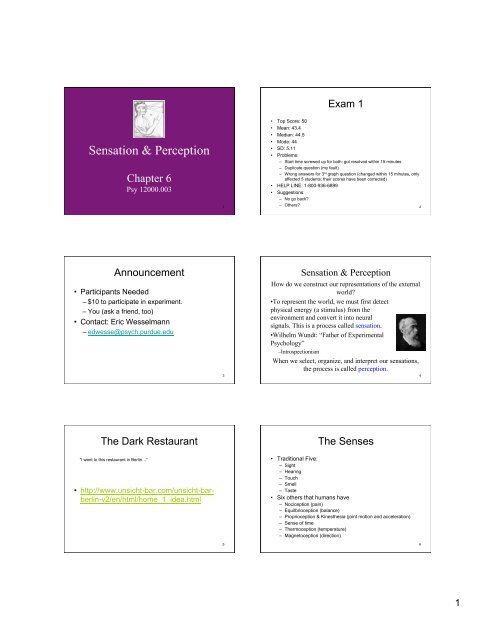
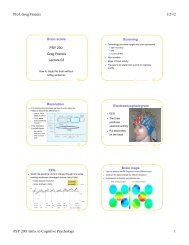

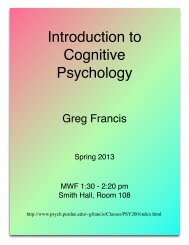
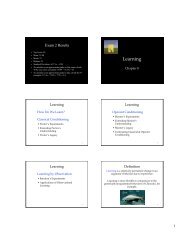
![Exam 4 Study Guide[1]](https://img.yumpu.com/45196739/1/190x245/exam-4-study-guide1.jpg?quality=85)
